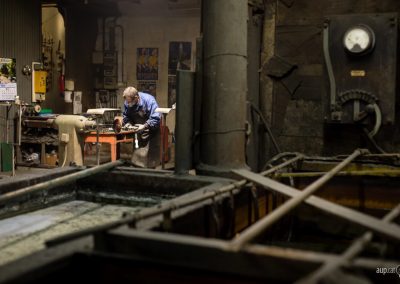P7: Plaça de la Independència
Seventh stop
Plaça de la Independència
(R. Alberch, P. Freixes, E. Massanas, J. Miró, L. Xifra. L’enllumenat elèctric a Girona. 1833-1930. Ed. Ajuntament de Girona).
In 1886 the lighting was officially implemented. Gas lamps disappeared, beginning with the most central places, like this square.
Incandescent processes are even more familiar to us: the sun, lightning, and fire. Or light bulbs. In fact, when light bulbs are lit, they are said to burn, a word with two meanings that are valid in this case: it is light and hot. An English physicist named Joule discovered that if an electric current is made by a conductor, it heats up.
If it heats up a lot, it can result in light. This happens in light bulbs. They have a very long, thin wire made of a metal called tungsten. Tungsten has a property that makes it especially interesting in this case, which is that it can be heated to a very high temperature without melting. In a light bulb, the thread reaches 2,500 degrees, but tungsten does not melt until it approaches 3,700 degrees. The problem with light bulbs is that a large portion of the electrical energy produced, between 80% and 90%, does not make light. The energy is lost in the form of infrared light, which translates into heat.
With the intention of increasing tungsten’s lifespan, halogen lamps were invented. The principle is the same, only there is another gas in addition to argon in the bulb: a halogen. When tungsten sublimates and reacts with the halogen, a salt forms, which when deposited on the filament turns back into tungsten. Thus, this creates a kind of cycle that allows the lamp to last longer. However, the problem of energy loss is still present.

Foto Oimax (Flickr)
Still one more type of light source can be seen here: neon. Unlike the previous examples, neon emits light in certain colors, which makes it useful in light-up signs. Neon lights operate when an electric current runs through a gas at low pressure. It is similar to mercury, but in this case the radiation is not ultraviolet, but visible, and more specifically gives off a red light. The other neon colors are achieved with different gases, but the method is identical.

Did you know?
Many ghost stories are told in cemeteries, and it is true that many people have seen lights. This phenomenon has a chemical explanation. When a person is buried, a decomposition process begins, which first affects the soft tissues and continues with the bones. Bones mostly consist of calcium carbonate – remember the second stop on this tour – but they also contain phosphorus. When they break down, this material is released as a gas, which can escape through cracks in the coffins, since they are not hermetic. When it reaches the surface, these gases emit a weak light, caused by the phosphorescence of the element.
The Hound of the Baskervilles, by Sir Arthur Conan Doyle, had this effect to thank in part for its phantasmagoric, diabolical appearance.
Llum
La llum és la classe d’energia electromagnètica radiant que inclou el rang sencer de radiació conegut com l’espectre electromagnètic.
L’espectre electromagnètic abarca totes les longituds d’ona (lambda) que la llum pot prendre. On la longitud d’ona és una magnitud física que indica la mida d’una ona, és inversament proporcional a la freqüència (nu) i la l’energia (E) segons la relació:
![]()
La llum visible és aquella porció de l’espectre electromagnètic que l’ull humà pot percebre, amb longituds d’ona entre aproximadament 400 nm i 800 nm. Les diferents longituds d’ona, dins el visible, s’interpreten al cervell humà com colors, des del vermell a les longituds d’ona més grans (freqüències més baixes) fins al violeta (freqüències més altes).

Joule
James Prescott Joule (1818 Salford-1889) fou un físic anglès que estudià la naturalesa de la calor i en descobrí la relació amb el treball mecànic, fet que dugué a la teoria de la conservació de l’energia. Descobrí la relació entre el flux d’un corrent per una resistència i la calor dissipada, actualment anomenada llei de Joule.

Diode
Un díode és un dispositiu electrònic el funcionament del qual es pot extrapolar al d’una vàlvula de buit, ja que permet el flux del corrent elèctric en una direcció, però el bloqueig en el sentit contrari (restringint el moviment dels electrons).
Un díode LED, acrònim anglès de Light Emitting Diode (díode emissor de llum) és un dispositiu semiconductor que emet llum quan és travessat per corrent elèctric. El color de la llum emesa depèn del material semiconductor emprat en la construcció del díode podent variar des de l’ultraviolat, passant per l’espectre de llum visible, fins a l’infraroig.
El dispositiu semiconductor habitualment està encapsulat en una coberta de plàstic de gran resistència. Encara que el plàstic pot estar acolorit, és només per raons estètiques, ja que això no influeix en el color de la llum emesa.




















